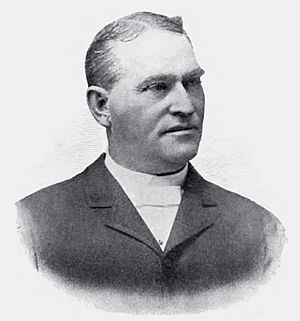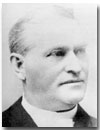William F. Fitzgerald facts for kids
Quick facts for kids
William F. Fitzgerald
|
|
|---|---|
 |
|
| Associate Justice, Arizona Territorial Supreme Court | |
| In office April 7, 1884 – October 31, 1885 |
|
| Nominated by | Chester A. Arthur |
| Preceded by | A. W. Sheldon |
| Succeeded by | William H. Barnes |
| Associate Justice, California Supreme Court | |
| In office February 2, 1893 – January 7, 1895 |
|
| Nominated by | Henry Markham |
| Preceded by | John R. Sharpstein |
| Succeeded by | Jackson Temple |
| 17th Attorney General of California | |
| In office January 7, 1895 – January 2, 1899 |
|
| Governor | James Budd |
| Preceded by | William H. H. Hart |
| Succeeded by | Tirey L. Ford |
| Personal details | |
| Born | February 7, 1846 Jackson, Mississippi |
| Died | May 12, 1903 (aged 57) Butte, Montana |
| Political party | Republican |
| Profession | Attorney |
William Francis Fitzgerald (born February 7, 1846 – died May 12, 1903) was an American lawyer and judge. He served as a judge on the federal court system in the Arizona Territory. He was also a judge on the California Supreme Court, which is the highest court in California. Besides being a judge, he was the chief lawyer for the state of California and a judge for the Superior Court of Los Angeles County.
Early Life in Mississippi
William Fitzgerald was born on February 7, 1846, in Jackson, Mississippi. He went to public schools in his hometown. When he was 12, he worked as a newsboy. One person he delivered papers to helped him get into St. Mary's College (Kentucky). William studied there from late 1858 until the American Civil War began.
When the war started, William joined the Confederate States Army on March 27, 1861. He fought in many battles, including the Battle of Shiloh. He was also injured during the war. A newspaper later wrote that William, at just 17, bravely charged enemy positions. He was wounded in this action. Because of his bravery, he was promoted to first lieutenant on the battlefield.
After the war, William began studying law. He became a licensed lawyer in Mississippi on February 18, 1868. He then started his law practice in Jackson. William married twice, both times to daughters of Dr. C. S. Knapp. He had one daughter.
William joined the Republican Party, which was unusual for someone from the Southern United States at that time. He was elected district attorney twice for a four-year term. This job meant he was the main prosecutor for a specific area around Jackson and Vicksburg. In 1881, he was nominated to be the Mississippi Attorney General but did not win the election. In 1882, he ran for the United States Senate but also lost.
Serving in Arizona Territory
In February 1883, William Fitzgerald went to a convention in Washington D.C. There, he met President Chester A. Arthur. The President asked William if he would like a job working for the federal government. William asked to be a judge in the Dakota Territory.
On March 3, 1884, President Arthur nominated William to be a judge on the Arizona Territorial Supreme Court. This happened after another judge, A. W. Sheldon, passed away. The United States Senate approved his nomination a week later. William took his oath of office on April 7, 1884. He was assigned to a judicial district that included Graham, Pima, and Pinal counties. Later, it changed to Cochise, Graham, and Pima counties. He lived in Tucson.
Only one of his rulings from this time is still known: Smith v. County of Mohave (1885). In this ruling, he decided that a law from 1881 did not stop people from being able to sue a county in Arizona.
When Grover Cleveland became President in 1885, William's time as a judge in Arizona ended. Judges appointed by the previous president were often replaced. People in the territory liked William, and they held meetings to try and keep him as a judge. Despite their efforts, President Cleveland named William H. Barnes as William's replacement on October 23, 1885. William Fitzgerald officially swore in his successor on October 31, 1885.
Career in California
William Fitzgerald moved to Los Angeles, California, in early 1886. He worked with different law firms there. He was also very active in the local legal community. For example, he helped reorganize the Los Angeles Bar Association in 1888. Outside of law, he was the chairman of the board for the Los Angeles Chamber of Commerce. He was also a director for the California Sewer Pipe Company. He was active in the Republican Party in California and became chairman of the party's central committee in 1892.
In 1891, William became a Supreme Court Commissioner. This role helped the Supreme Court with its work. He held this job until May 1892. Then, he joined a law firm in San Francisco. On February 2, 1893, Governor Henry Markham appointed William to fill a vacant seat on the California Supreme Court. He served on this court for two years and wrote 32 legal opinions.
Instead of running for reelection to the California Supreme Court, William decided to run for California Attorney General in 1894. He won this election and started his four-year term on January 7, 1895. As his term was ending, he ran for San Francisco city attorney but lost. After leaving office, William went back to practicing law in San Francisco.
In late 1899, Governor Henry Gage appointed William to the Superior Court of Los Angeles County. He filled the remaining term of a judge who had passed away. He held this position for two years but did not win reelection in 1902. In April 1903, William traveled to Butte, Montana, to visit his daughter and son-in-law. He passed away there on May 12, 1903, from heart failure. William Fitzgerald was buried in Holy Cross Cemetery in Butte.
See also
- List of justices of the Supreme Court of California
| Legal offices
|
||
|---|---|---|
| Preceded by William H. H. Hart |
California Attorney General 1895–1899 |
Succeeded by Tirey L. Ford |
| Preceded by John R. Sharpstein |
Associate Justice of the California Supreme Court 1893–1895 |
Succeeded by Jackson Temple |


